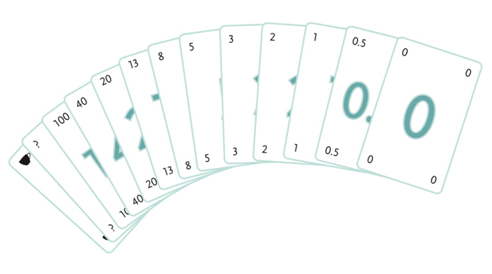Planning Poker
Description
Planning Poker is consensus based technique for estimating Product Backlog items or other things in Scrum. Usually teams estimate the relative size of items. Planning Poker results in reliable and efficient estimations because the team gains a common understanding about the items. Planning Poker is a variation of the Wideband Delphi method.


Planning Poker is based on a list of items to be estimated and a deck of cards. The list of items could e.g. be software items or a work breakdown structure.
The whole team participates. Each person is given one set of the cards.
A moderator who will not play chairs the meeting.
The team decides what units are estimated. They can be days duration, ideal days or story points.
Each item is estimated in 4 steps until consensus is reached.
The steps are:
The steps are:
- Each item is presented for estimation. The team briefly discusses each item.
- Each estimator lays a card face down representing his estimate.
- Everyone calls their cards simultaneously by turning them over.
- People with high estimates and low estimates explain their estimate. The group continues to discuss and re-estimate the item until the estimates converge.
Hints:
- The point is not absolute precision but reasonableness.
- It’s a good idea to write down a short summary of the discussion for each estimated item.
The card deck consists of the numbers 0, 0.5, 1, 2, 3, 5, 8, 13, 20, 40, 100, a question mark and a coffee break card.
The cards are numbered to account for the fact that the higher an estimate is, the more uncertainty it contains. The defined set of numbers Speeds up the estimation processby limiting the number of choices, avoids a false sense of accuracy for high estimates, encourages the team to split large items into smaller ones.
The cards are numbered to account for the fact that the higher an estimate is, the more uncertainty it contains. The defined set of numbers Speeds up the estimation processby limiting the number of choices, avoids a false sense of accuracy for high estimates, encourages the team to split large items into smaller ones.
Special cards: The question mark is used when an estimator has not enough information to make an estimate. The coffee break card is used when an estimator needs a break. “0” means that item is already done.
Requirements
Checkliste: Planning Poker
- Alle Teilnehmer der Schätzung kennen die „Maßeinheit“: Stunden, Tage, Story Points, Function Points etc.
- Bei relativer Schätzung: Jeder Schätzer kennt den Referenz-Eintrag
- Alle Teilnehmer schätzen für sich, legen ihre Karte erst offen, nachdem jeder eine Schätzung im Kopf hat
- Wenn Diskussionen zu weiteren Erkenntnissen führen, wird die Definition der Einträge entsprechend angepasst
- Ein Moderator unterstützt den Prozess. Für jeden Eintrag:
- Schritt 1: Story/Eintrag erklären und kurze Runde mit Klärungsfragen
- Schritt 2: Jeder schätzt für sich und wählt eine entsprechende Karte
- Schritt 3: Karte herumdrehen und zeigen
- Schritt 4: Frage nach Begründung von niedrigstem und höchstem Schätzer
- Wiederholt Schritte 2, 3, 4 durchführen, bis ein Konsens erreicht ist
Is included in
- Techniques for Agility
- This page contains a collection of techniques that are often used in conjunction with Scrum.
